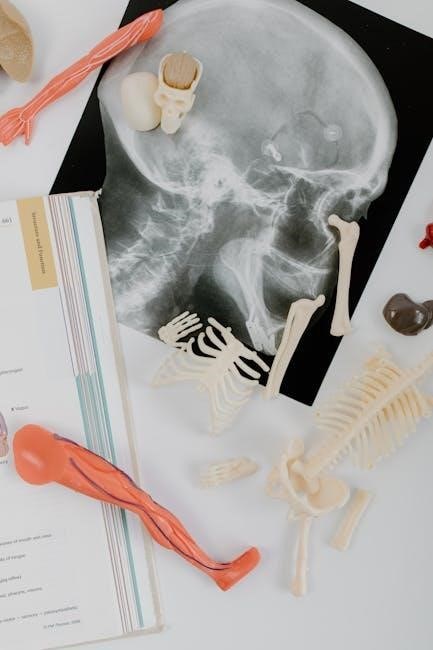The Math 53 Final Exam 2019 is a comprehensive assessment covering key calculus topics. This document provides an overview, importance, and structure to help students prepare effectively for the exam.
1.1 Overview of the Math 53 Final Exam
The Math 53 Final Exam 2019 is designed to assess students’ understanding of multivariable calculus and its applications. It covers key topics such as continuity, differentiation, and optimization, with a focus on problem-solving and critical thinking. The exam includes multiple-choice questions, open-response problems, and complex scenarios involving global temperature models. Students are expected to demonstrate proficiency in applying mathematical concepts to real-world challenges. The exam structure emphasizes both theoretical knowledge and practical skills, ensuring a comprehensive evaluation of student learning. Preparation materials, including past papers and practice tests, are available to help students familiarize themselves with the exam format and content. This overview highlights the essential aspects of the exam, providing a clear roadmap for effective preparation.
1.2 Importance of the 2019 Exam
The 2019 Math 53 Final Exam holds significant importance as it evaluates students’ mastery of multivariable calculus and its applications. It serves as a capstone assessment for foundational math skills, ensuring readiness for advanced studies. The exam’s comprehensive nature, covering topics like continuity, differentiation, and optimization, makes it a critical benchmark for academic progress. Additionally, it incorporates real-world applications, such as global temperature models, to test practical problem-solving abilities. The exam’s difficulty and thoroughness require students to demonstrate both theoretical knowledge and computational proficiency. Preparation for this exam is essential, as it reflects the culmination of key concepts learned throughout the course. By succeeding in this exam, students validate their understanding and readiness for more complex mathematical challenges in their academic and professional pursuits.
1.3 Structure of the Document
This document is organized into seven main sections to provide a comprehensive guide for the Math 53 Final Exam 2019. The introduction outlines the exam’s overview, importance, and document structure. The second section details key topics, including continuity, differentiation, multiple-choice questions, optimization, and global temperature models. The third section offers study resources such as past exams, practice tests, online quizzes, and recommended textbooks. The fourth section explains the exam format and grading criteria. The fifth section provides detailed solutions and strategies for complex problems. The sixth section shares preparation tips, including effective practice and time management. Finally, the conclusion summarizes the document and encourages students to utilize the resources effectively. This structured approach ensures students are well-prepared for the exam by covering all necessary aspects of the course material and exam strategy.
Key Topics Covered in the Exam
The exam focuses on continuity, differentiation, multiple-choice questions, optimization problems, and global temperature models, ensuring a comprehensive assessment of calculus and problem-solving skills.
2.1 Continuity and Differentiation
Continuity and differentiation are fundamental concepts in calculus, heavily emphasized in the Math 53 Final Exam 2019. Students are expected to demonstrate a deep understanding of limits, derivatives, and their applications. Key topics include continuity at a point, the formal definition of a derivative, and the differentiation rules such as the power rule, product rule, and chain rule. Problems often involve proving continuity, finding derivatives of complex functions, and applying derivatives to real-world scenarios like optimization and related rates. The exam also covers implicit differentiation and parametric equations, ensuring students can handle various function types. Practical applications, such as modeling global temperature changes, highlight the relevance of these concepts. Mastery of continuity and differentiation is crucial for success in the exam, as these topics form the backbone of calculus and are extensively tested.
2.2 Multiple-Choice Questions and Solutions
The Math 53 Final Exam 2019 features a mix of question types, with multiple-choice sections designed to test foundational knowledge and problem-solving skills. These questions cover a wide range of topics, including continuity, differentiation, optimization, and global temperature models. Each question is carefully crafted to assess the student’s ability to apply concepts to specific scenarios. Detailed solutions for these multiple-choice questions are provided, offering step-by-step explanations to help students understand the reasoning behind each answer. By reviewing these solutions, students can identify areas where they need additional practice and refine their strategies for tackling similar problems in the future. The inclusion of both questions and solutions makes this resource invaluable for exam preparation, ensuring students are well-equipped to handle the challenges of the Math 53 Final Exam.
2.3 Optimization Problems and Constraints
Optimization problems in the Math 53 Final Exam 2019 require students to find maximum or minimum values of functions subject to specific constraints. These problems often involve multivariable calculus, where students must apply methods like Lagrange multipliers to solve for extrema. Constraints can be equality or inequality conditions, defining feasible regions for optimization. For example, problems may ask to maximize a function like ( f(x, y, z) = xyz ) under a constraint such as ( x^2 + y^2 + 2z^2 = 10 ). Detailed solutions demonstrate how to set up and solve these optimization problems, emphasizing critical thinking and mathematical rigor. Practice exams and review materials highlight these types of questions, ensuring students are prepared to tackle complex scenarios. Understanding optimization is crucial, as it appears frequently in the exam and is a cornerstone of advanced calculus applications.
2.4 Global Temperature Models
Global temperature models in the Math 53 Final Exam 2019 involve mathematical representations of Earth’s average temperature over time. These models often incorporate calculus concepts, such as differentiation and integration, to analyze and predict temperature trends. For instance, a model might express temperature as a function of time, ( x(t) ), and ask students to interpret or solve related problems. Practice exams include questions where students must find rates of change or cumulative temperature increases, demonstrating the application of calculus to real-world scenarios. Review materials highlight the importance of understanding these models, as they are frequently used in environmental and scientific studies. Detailed solutions provide step-by-step guidance, ensuring students can approach such problems confidently. This section bridges theoretical calculus with practical, global issues, making it a valuable part of the exam preparation process.

Study Resources and Materials
Past exam papers, practice tests, online quizzes, and recommended textbooks are essential resources for preparing for the Math 53 Final Exam 2019. These materials provide comprehensive practice opportunities and detailed solutions.

3.1 Past Exam Papers and Solutions
Past exam papers and solutions are invaluable resources for preparing for the Math 53 Final Exam 2019. These materials provide students with insights into the exam format, question types, and expected difficulty levels. By reviewing previous years’ exams, students can identify recurring topics and practice solving similar problems. Solutions to past exams are particularly useful, as they offer step-by-step explanations for complex questions, helping students understand where they might go wrong. For instance, the 2019 exam included questions on continuity, differentiation, and optimization, with detailed solutions available online. Additionally, practice tests and review packets are often distributed by instructors or found on university websites. These resources not only reinforce conceptual understanding but also help students manage their time effectively during the actual exam. Utilizing these materials ensures a well-rounded preparation strategy.

3.2 Practice Tests and Review Packets
Practice tests and review packets are essential tools for preparing for the Math 53 Final Exam 2019. These resources are designed to simulate the actual exam experience, helping students familiarize themselves with the format and content. The mathematics department often provides review packets containing practice questions that cover key topics such as continuity, differentiation, and optimization. For instance, the 2019 review packet included 50 open-response questions, focusing on calculus concepts and problem-solving strategies. Additionally, practice tests from previous years, such as those from 2018 and 2019, are available online, offering students the opportunity to assess their understanding of complex problems. By working through these materials, students can identify weak areas, refine their problem-solving techniques, and improve their time management skills. Regular practice with these packets ensures a thorough preparation for the final exam.
3.3 Online Quizzes and Study Groups
Online quizzes and study groups are valuable resources for preparing for the Math 53 Final Exam 2019. These tools provide interactive learning opportunities, helping students test their knowledge and collaborate with peers. Many websites offer quizzes covering topics like continuity, differentiation, and optimization, allowing students to identify areas needing improvement. For example, platforms like Bibmth and YouMath offer random problem generators for calculus topics, enabling students to practice under timed conditions. Study groups, both online and in-person, foster collaborative learning, where students can discuss complex problems and share problem-solving strategies. Resources like the 2019 review packet and practice finals are often used in these groups to work through challenging questions collectively. Participating in these activities enhances problem-solving skills, promotes active learning, and builds confidence for the exam. They complement traditional study methods, ensuring a well-rounded preparation strategy.
3.4 Recommended Textbooks and Guides
Recommended textbooks and guides are essential for thorough preparation for the Math 53 Final Exam 2019. Textbooks like “Digital Design and Computer Architecture” by David Money Harris and “Trudy” journals provide in-depth explanations of calculus concepts and practical examples. Online resources, such as the 2019 review packet and practice finals, offer structured materials to reinforce learning. Guides like the “Reviewer for UP Math 53” include detailed solutions to past exam questions, helping students understand problem-solving techniques. Additionally, resources like “Math W53 Final Exam solutions” provide insights into complex topics such as optimization and global temperature models. These materials are widely recognized for their clarity and relevance, making them indispensable for students aiming to excel in the exam. They complement online quizzes and study groups, offering a comprehensive approach to exam preparation. Consistent use of these resources ensures a strong grasp of key concepts and exam strategies.

Exam Format and Structure
The Math 53 Final Exam 2019 includes multiple-choice and open-response questions, focusing on calculus topics like continuity, differentiation, and optimization. The exam is timed, with strict submission deadlines.
4.1 Types of Questions and Sections
The Math 53 Final Exam 2019 is divided into multiple sections, including multiple-choice questions and open-response problems. The exam assesses understanding of calculus concepts such as continuity, differentiation, and optimization. Sections are designed to test problem-solving skills, with questions ranging from basic to complex. The multiple-choice portion evaluates quick recall and application, while open-response questions require detailed solutions and logical reasoning. Additionally, the exam includes sections focused on global temperature models and related calculus applications. Students are expected to demonstrate proficiency in both theoretical and practical aspects of the course material. The structure ensures a comprehensive evaluation of knowledge acquired throughout the semester, emphasizing critical thinking and analytical abilities. Proper time management and familiarity with question formats are essential for success. This section provides a clear breakdown of the exam’s composition to aid in targeted preparation.
4.2 Grading Scale and Evaluation Criteria
The Math 53 Final Exam 2019 uses a grading scale based on percentage accomplishment, with specific grade ranges corresponding to exam marks. For instance, 95-100% achievement corresponds to 57-60 points, earning an A grade. Similarly, 89-94% is graded as a B, while lower percentages receive lower grades. The exam is evaluated based on accuracy, completeness, and adherence to mathematical principles. Multiple-choice questions are scored for correct answers, while open-response problems assess both the solution and the reasoning process. Partial credit is awarded for partially correct answers, emphasizing the quality of work shown. The grading criteria ensure fairness and transparency, reflecting a student’s mastery of the course material. Understanding the grading scale helps students aim for specific targets and evaluate their performance effectively.

Solutions and Answer Keys
This section provides detailed solutions for practice exams, multiple-choice answer keys, and strategies for solving complex problems, ensuring comprehensive preparation for the Math 53 Final Exam.

5.1 Detailed Solutions for Practice Exams
Detailed solutions for practice exams offer step-by-step explanations, helping students understand problem-solving methods. These solutions cover various topics, ensuring a thorough grasp of calculus concepts. They also highlight common pitfalls and provide tips for avoiding errors. By reviewing these solutions, students can identify areas needing improvement and refine their techniques. The explanations are clear and concise, making complex problems more approachable. Additionally, the solutions emphasize key strategies for tackling difficult questions, enhancing overall exam readiness. Regular review of these materials can significantly boost confidence and performance. Students are encouraged to work through problems independently before consulting the solutions to maximize learning effectiveness. This resource is invaluable for self-study and exam preparation, ensuring a solid understanding of the material.
5.2 Answer Key for Multiple-Choice Questions
The answer key for multiple-choice questions provides clear and accurate responses to each problem. It helps students verify their answers quickly and efficiently. The key is organized by question number, making it easy to navigate. Each answer is accompanied by a brief explanation, ensuring understanding. This resource is essential for identifying strengths and weaknesses. By reviewing the answer key, students can focus on areas needing improvement. The explanations are concise yet informative, aiding in grasping concepts. Regular use of this key enhances problem-solving skills and exam readiness. It is a valuable tool for self-assessment and learning, ensuring students are well-prepared for the final exam. Utilizing this resource regularly can significantly improve performance and confidence in tackling multiple-choice questions effectively.
5.3 Strategies for Solving Complex Problems
Mastering complex problems requires a systematic approach. Begin by understanding the problem statement thoroughly. Break down intricate questions into manageable parts, focusing on one step at a time. Utilize visualization tools like graphs and diagrams to simplify abstract concepts. Identify key variables and constraints, as these often hold the solution. Practice applying fundamental theorems and formulas, ensuring a strong foundation. For optimization problems, consider using Lagrange multipliers or evaluating critical points. Verify solutions by plugging them back into the original equation or using second derivative tests. Collaborative learning and discussing challenging problems with peers can provide new insights. Time management is crucial; allocate specific intervals for each problem type during practice. Regularly reviewing past exams and solutions sharpens problem-solving skills. These strategies collectively enhance analytical thinking and confidence, leading to improved performance on complex exam questions.
Preparation Tips and Advice
Effective preparation involves consistent practice, understanding exam format, and managing time wisely. Review past papers, join study groups, and use recommended resources to build confidence and mastery of key topics.
6.1 Understanding the Exam Format
Understanding the Math 53 Final Exam format is crucial for effective preparation. The exam typically includes multiple-choice questions, open-response problems, and complex calculus tasks. It is divided into sections, each focusing on specific topics like differentiation, continuity, and optimization. Time management is essential, as students must allocate their time wisely across all sections. Familiarizing oneself with the exam structure helps reduce anxiety and allows for a more strategic approach during the test. Reviewing past papers and practice exams can provide insights into the types of questions and their formatting. Additionally, understanding the grading criteria ensures that students know how to present their solutions clearly and comprehensively. By knowing what to expect, students can optimize their performance and tackle the exam with confidence.
6.2 Effective Practice and Time Management
Effective practice and time management are essential for excelling in the Math 53 Final Exam. Start by reviewing past exam papers to familiarize yourself with the format and difficulty level. Allocate dedicated time for each topic, focusing on your weaknesses. Create a structured study schedule, ensuring consistent practice and regular breaks to maintain focus. Prioritize problem-solving exercises, especially for calculus, optimization, and differentiation. Use practice tests to simulate exam conditions, helping you manage time efficiently. Review solutions thoroughly to understand mistakes and improve problem-solving strategies. Balance your study sessions with short breaks to avoid burnout. By organizing your practice and time wisely, you can enhance your readiness and confidence for the exam.
6.3 Joining Study Groups for Better Understanding
Joining study groups can significantly enhance your understanding of complex mathematical concepts. Collaborative learning allows you to discuss challenging problems with peers, clarifying doubts and gaining new insights. Study groups foster a supportive environment where students can share knowledge and approaches, often leading to a deeper grasp of topics like continuity, differentiation, and optimization. Additionally, group discussions can help identify common misconceptions and weaknesses, enabling focused revision. Many universities and online platforms offer study group resources, making it easier to connect with fellow students. Actively participating in these groups can also improve problem-solving skills through shared strategies and explanations. By engaging in regular study sessions with others, you can stay motivated and build confidence for the exam. This collaborative approach complements individual practice, ensuring a well-rounded preparation for the Math 53 Final Exam.
The Math 53 Final Exam 2019 is a challenging assessment requiring thorough preparation. By understanding the exam structure, practicing past papers, and utilizing study resources, students can build confidence. Collaboration with peers through study groups enhances problem-solving skills and clarifies doubts. Regular practice, time management, and a strategic approach are essential for success. Reviewing detailed solutions and understanding grading criteria help refine study strategies. While the exam covers complex topics like continuity, differentiation, and optimization, consistent effort and effective resources ensure readiness. This document provides a comprehensive guide to aid students in their preparation journey. Stay focused, utilize available materials, and approach the exam with a well-prepared mindset to achieve optimal results.